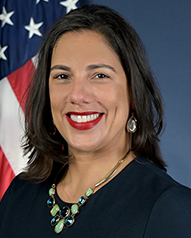It’s Go Time: BIL Year Three is When the Rubber Meets the Road
By FTA Acting Administrator Veronica Vanterpool | 4/8/2024
BY VERONICA VANTERPOOL
FTA Acting Administrator

At the APTA Legislative Conference this week, we will reconnect with partners throughout the transit industry and focus on the impact of our work supporting public transportation for America’s communities. Secretary Buttigieg likes to say that in this third year since the Bipartisan Infrastructure Law (BIL), we will deliver more funding for more good projects than ever before.
I was honored to take the helm as FTA Acting Administrator in February. Our talented and committed FTA team is dedicated to working with you to continue making the most of the $108 billion authorized by BIL, the most significant federal investment in transit during our lifetimes.
We are fortunate to have this generational investment in American transit infrastructure. Now, halfway through the BIL’s five years of authorized federal funding, we are showing that this downpayment on America’s infrastructure is worth the investment.
Equity considerations are at the forefront as we manage the four new programs created by the BIL, which provide $2.7 billion in new funding to address significant needs in the industry. Just looking at 2023 and early 2024, here is a summary of FTA’s investment through those new programs:
- Rail Vehicle Replacement: $703.1 million to six transit agencies. And in February 2024, FTA announced a second round of selections of $631 million for rail fleets at three transit systems.
- All Stations Accessibility: $686 million to 15 transit agencies. We look forward to announcing the next round of grants soon.
- Expanded passenger ferry programs (Rural Ferry and Low–Emitting Ferry): $220.2 million for 13 ferry projects.
In addition to new grant opportunities, FTA Low- and No-Emission program funding increased 600 percent since FY 2021 to $1.1 billion in FY 2024. This one program supports several Biden-Harris Administration goals, including reducing greenhouse gas emissions, creating jobs through workforce training, and expanding transit into underserved areas using Justice40 principles.
Through the first two rounds of competitive bus funding, FTA invested $3.3 billion to support low- and no-emission buses as well as traditional buses and facilities. From that list, more than a quarter of the projects serve organizations in rural or tribal areas, which is another way we are expanding support for transit in areas that may have been underserved.
Focusing on those rural and tribal areas, along with Justice40 concerns, demonstrates how all our work is underpinned by a focus on equity. We are committed to righting the wrongs of the past and ensuring that transit is available to everyone. Along with our colleagues throughout the U.S. Department of Transportation, we are providing more federal support to make up for decades of neglect.
We can be especially proud that over the last two years, FTA has awarded grants for—and our funding recipients are now delivering close to 3,000—new low- and no-emission buses, including nearly 2,000 zero-emission vehicles in service. Many of the 60,000 transit buses driving America’s roads serve communities where disinvestment and pollution has caused poor air quality. More zero-emission buses mean fewer childhood asthma cases, clearer skies, and longer lives.
To get more clean buses on the road, we must make it easier to buy American-made vehicles. By adding a priority consideration to our competitive bus program notice of funding opportunity, we are encouraging applicants to avoid over-customization during procurement.
To create more housing—particularly affordable housing—we have asked those interested in our transit-oriented development planning grants to demonstrate how their projects will reduce housing costs and transform land use near transit.
FTA also continues supporting large transit construction projects through the Capital Investment Grants program. In 2023, we signed seven agreements totaling $4 billion in communities across the nation. In President Biden’s Fiscal Year 2025 Budget Request to Congress submitted last month, FTA recommended that 14 large transit projects in 11 states receive nearly $4 billion in federal support. These rail and bus rapid transit projects will bring transformative change by attracting new riders, creating jobs, and jumpstarting economic development.
The BIL also required FTA to help make the safest mode of transportation even safer. Transit worker safety is paramount, as frontline workers have experienced a significant increase in assaults since the pandemic. To tackle that issue, FTA issued a proposed general directive that calls upon industry leaders to address the significant and continuing risk for transit workers. We look forward to progress ensuring everyone can perform their jobs safely.
And finally, this year the federal transit program turns 60. President Johnson signed the Urban Mass Transportation Act on July 9, 1964. Public transportation has come a long way from that initial law funding some scattered bus networks and a few urban rail systems to where we are today. FTA’s current portfolio includes a $21 billion annual budget supporting more than 3,500 transit providers. Please see FTA’s video series highlighting the success of the federal transit program. Everyone in the public transportation sector has contributed to our success, and we’ll continue spotlighting this major work through the July anniversary.
I look forward to connecting with many APTA members at this year’s conference and throughout the year.